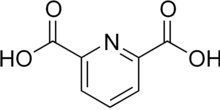Difference between revisions of "Dipicolinic acid"
(Created page with "220x220px Dipicolinic acid is a disubstituted pyridine derivative containing two carboxylic acid groups. It is commonly found in ba...") |
(No difference)
|
Revision as of 03:40, 14 June 2015
Dipicolinic acid is a disubstituted pyridine derivative containing two carboxylic acid groups. It is commonly found in bacterial spores, as it confers heat resistance to the endospore. It is a powerful complexation agent and has several uses in biochemistry and transition metal chemistry.
Contents
Properties
Chemical
Dipicolinates are good chelation agents. There are multiple free electron pairs on the molecule, one on the lone nitrogen atom and two on oxygen atoms in the carboxylate groups, making it a tridentate ligand. Numerous metals will complex to the dipicolinate ion, most notably chromium and the lanthanides.
Physical
When dipicolinic acid is added to lanthanide ions, the dipicolinato groups are able to transfer the energy of ultraviolet light to the lanthanide ion, resulting in greater fluorescence. By substituing all of the water molecules which normally coordinate to a lanthanide ion, it reduces the absorption of ultraviolet light and fluorescence is enhanced, especially in solution.
Dipicolinic acid melts at 248-250°C.
Availability
Chromium dipicolinate is available as a supplement, but this is an impractical method of producing dipicolinic acid.
Preparation
Dipicolinic acid may be synthesized froom 2,6-dichloropyridine.
Projects
- Fluorescent compounds of lanthanides
- Chromatography
Safety
Dipicolinic acid is an irritant.
